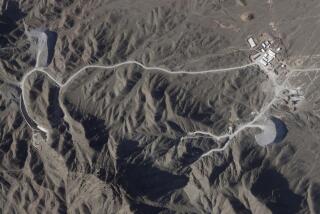Phone Lines, Sewer Rats, Sunless Sea; No Xanadu Under Our Feet : Discovery: In the cities, the netherworld holds the conduits of civilization. In the imagination, it holds treasure. What’s below can be frightening or amazing.
- Share via
Demons may live down there.
If so, they have a lot to contend with: Gas lines, water mains, utility cables, sewers, subways, steam pipes, abandoned tunnels, treasure vaults, burial chambers, rivers--even seas.
Regarded by people all over the globe as a dwelling place of spirits, often evil ones, the nether regions have been a rich source of myths and legends through the ages. But the realities of what lies underfoot are sometimes even more surprising.
The busiest underworlds, by far, lie beneath the concrete crusts of great cities. The areas below are interlaced with cats, cradles of cables and conduits that deliver utilities and communication.
“We put everything we can underground,” Susan Moyer of Potomac Electric Power Co. in Washington said. The utility lights up the 68-square-mile city with 6,700 miles of operating circuits.
More than 100 miles of steam lines, the nation’s largest steam-heating system, occasionally remind New Yorkers of their presence in spectacular ways. A 1989 explosion killed three people, injured 24 and forced the evacuation of 500 from their homes.
Breaks are frequent in the city’s more than 5,700 miles of water mains. Last Sunday, a 92-year-old water main ruptured, buckling a Times Square street and flooding subway lines.
Like those in many other large cities, New York’s underground is such a tangle that before foundations for new buildings can be put down, consulting engineers must sort out and move existing cables and pipes.
New construction is always turning up abandoned and often forgotten relics.
Workers installing a phone line beneath a venerable hotel on Washington’s Pennsylvania Avenue in the 1940s discovered a cavernous vault. The hotel management disclaimed any knowledge of it.
Some years ago, workers digging near the U.S. Capitol ran into an abandoned tunnel, presumably a sewer, that didn’t show up in any records. Running east and west, its thick masonry walls and flat brick arch indicated it was very old, but exactly how old no one could say. Nor was anyone sure where it began or ended.
Tiber Creek, one of the Anacostia River’s principal tributaries, is periodically rediscovered. It now runs through brick conduits under Washington’s streets and buildings from Union Station past the Capitol, draining more than half the city.
Sewers can be fun. Istanbul, Paris and Vienna find theirs so fascinating that they offer tours. Fugitive Jean Valjean led Inspector Javert on a memorable chase through parts of Paris’ 1,313 miles of navigable sewers in Victor Hugo’s “Les Miserables.” Paris’ underground waterway also harbored the Phantom of the Opera in Gaston Leroux’s classic.
Authorities periodically debunk urban myths of gigantic turtles and alligators slithering through sewers, the supposed results of unwanted but fast-growing Florida souvenirs flushed down toilets.
Nonsense, say the authorities. But watch out for the rats.
Probably since people used seashells for currency, they’ve buried treasure. This may account for the inflammatory effects that many subterranean discoveries have had on the imagination.
During construction near the Capitol in the 1930s, workers ran into a tunnel described as long, muddy and mysterious. Somebody suggested that it was part of a 17th-Century network of tunnels leading to a treasure buried by the infamous pirate Capt. Kidd.
Like the tunnel, that suggestion went nowhere.
Some underground vaults contain genuine treasures, like the billions of dollars in gold stored below the Federal Reserve Bank in New York. The world’s largest gold hoard belongs to some 40 countries that find the location more convenient for trading, and possibly safer, than an above-ground vault.
Nottingham, England, sits atop a honeycomb of caves and tunnels that have been carved out of the pebbly limestone.
The human excavations, some dating back a thousand years, have been used for a variety of purposes: food storerooms, breweries, tanneries, wells, cesspits and, during conflicts dating from medieval times through World War II, shelters.
Much of what lies below has to do with water--submerged streams, rivers, even larger bodies of water.
A series of large heated pools in caves around the foothills of the Caucasus Mountains, which lie on the border of Russia and Georgia, are as hot as 158 degrees Fahrenheit and are outlets of a large, submerged freshwater sea.
But death is what most people associate with the underworld. Tourists entering Paris’ catacombs, a labyrinth of abandoned rock quarries containing 6 million skeletons, are warned: “Stop, here is death’s empire. A little respect.”
Most find this advice superfluous as they wander through dimly lit, seemingly endless corridors and galleries lined with bones and skulls.
Law-enforcement authorities worry about underground passageways as possible venues for terrorism. Manhole covers near the White House and the Capitol have been sealed off as a result of terrorist scares.
Not even the underworld, it seems, is safe from evildoers.
More to Read
Sign up for Essential California
The most important California stories and recommendations in your inbox every morning.
You may occasionally receive promotional content from the Los Angeles Times.












